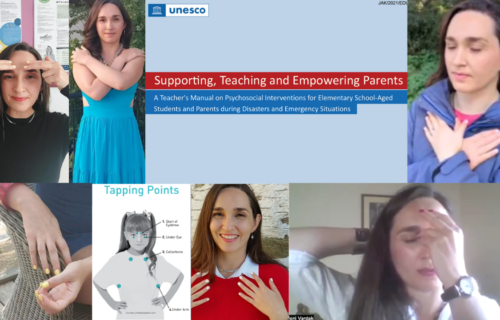
Reducing Student Stress
WHAT’S THE ISSUE: Teachers, parents and schools are investing heavily in wellbeing and mindfulness initiatives, but how do you know if it’s worth the investment? How can you know if it’s working for reducing student stress? In this article, I outline the 6 main ways I measure progress when I’m working with a stressed student. In a nutshell, I know we are making progress in reducing student stress when I can see:
- Progress in body posture and facial expressions.
- The student’s words and body language moving in a direction of re-integration.
- The student’s self-reported stress ratings are going down.
- The student is making progress in achieving his/her mentoring goals.
- The student is developing a more helpful mindset for accelerated learning and growth.
- Reduced negative coping strategies to self-soothe for stress (e.g. stress/emotional eating).
I use numbers 1, 2, 3, and 4 to measure progress in my one-month mentoring programs. However, it takes more than a one-month intervention to reduce stress enough to see progress in mindset or the student’s Enneagram stress response pattern’s. For this reason, I use 5 and 6 to measure progress in my 3-9 month mentoring programs, in addition to 1, 2, 3, and 4.
NO 1. OBSERVE THE STUDENT’S BODY POSTURE & FACIAL EXPRESSIONS
One of the first things I do at the start of a session, and when I first meet a student on Zoom, is to observe their posture. For example, if they have a collapsed body posture (i.e. hunched over, head tilted down, difficulty making eye contact), this tells me they are shut down. Their Autonomic Nervous System (ANS), which is the body’s response to an overwhelming amount of stress, is shut down. For cases like these, what I do is I look for signs that the student is starting to feel more safe and comfortable by sitting in a more confident, open-body posture.
The collapsed body posture is not uncommon to see in teenagers. So much so, that society sometimes dismisses this contracted posture as ‘just a normal phase teenagers go through – it will pass’. But if a parent cares about their child’s health and wellbeing, they need to understand that the human body only collapses like this due to overwhelming amounts of stress, whether that is acute (a really stressful incident) or chronic stress (overwhelming stress that occurs over a period of months or years). It is against the interests of your child’s health and happiness to dismiss these body posture signs of too much stress.
The other way I know a student is under a lot of stress is when they are sitting up in quite a tense, overly upright body posture (i.e. tense back, the shoulders may be raised up towards the ears, a startled/frozen/anxious facial expression). This is what is called the Freeze Mode of stress. What I’m looking for, here, is signs that their body posture is starting to soften and relax, which tells me that they are starting to feel comfortable and safe.
Finally, with regards to facial expression, whether a student is in the freeze or in the shut down stress response state, I know that progress is being made when I start to see a return of more expressive and responsive facial expressions. Because the “poker face”/ expressionless / unresponsive facial expression is another sign of too much tension and stress being held in the facial muscles.
NO 2. COMPARE WHAT THE STUDENT SAYS WITH WHAT THEIR BODY SAYS
One of the things I’m trained to do, as an accredited Emotional Freedom Technique practitioner, is to look for signs that what a client is saying seems to be contradicting what their body is saying. It is not uncommon for a student who is experiencing a lot of stress to have lost touch with their body. It may be that under stress, they go into over-thinking mode, and they worry and think about problems that need to be solved from the moment they wake up to the moment they fall asleep. It may be that they fear feeling certain painful emotions, such as fear or sadness. Whatever the reason may be, what matters is that they are saying they feel one way (i.e. “I feel sad”), but their body is not speaking the same language (i.e. They have a smile on their face). Another common sign of stress is when they say they feel a painful emotion (i.e. “I feel angry”), but their facial expression looks calm, almost like a poker-face. This is a sign that they are aware of their anger on an intellectual level, but they are not yet able to connect to it, on an emotional level.
In these cases, I know that the student I am working with is making progress on their journey of being able to process a build-up of stress the moment they are able to tolerate engaging with their suppressed emotions, on an emotional level. The smile on the face turns into downcast eyes, in the case of the kid who was finding it hard to connect with their sadness. The expressionless face turns into a furrowed brow, and you can hear the anger coming through in their voice, for the first time. All of these signs are the second way I measure progress in a stressed-out student’s emotional development self-awareness journey.
NO 3. ASK THE STUDENT TO REPORT HOW STRESSED THEY FEEL
As an EFT Practitioner, I am trained to systematically measure and track a students’ progress via what is called Subjective Units of Distress (SUDs). EFT, which stands for the Emotional Freedom Technique, is an evidence-based stress management tool. For example, say a student was experiencing exam stress for an upcoming Physics exam. They blanked out and had a panic attack on their last exam, even though they had studied a lot and were well prepared. They’re when now terrified that it might happen again.
The first step to using the Emotional Technique to reduce stress is to measure the intensity of the emotion, or physical sensation/tension/pain that comes up when the student thinks about the upcoming Physics exam, on a scale of 0 to 10 (10 being the most, 0 being the least). This 1 to 10 scale for distress, with each number representing being a ‘unit’ of distress, is a helpful way of increasing a student’s self-awareness.
Measuring progress in reducing student stress in this way is also helpful because kids often have their feelings and challenges ignored, dismissed or minimized by adults in daily life (E.g. “It’s all in your head”, “Just think positive thoughts.”, “Oh you’re just a child, what do you know of stress? Wait until you graduate from school.” ). It is therefore important for them to know that when they are working with me, they are coming into a safe, compassionate space where their emotional pain and body’s intelligence will be heard and respected. It is unethical to dismiss or minimize someone’s self-reported levels of distress. I monitor and support my clients in feeling better. I measure their progress in how much better they are feeling by checking in with them throughout a tapping session, and also at the end, using this self-reported system of SUDs.
Do I only use the 1 to 10 scale to measure progress? No. Because people are different, and therefore have different access points. For students who are younger, I use other modification to make the concept of SUDs more accessible, such as hand gestures (i.e. “How sad do you feel when you think of the stress of having to wear a mask in class – this sad, or this sad?” while motioning by bringing my hands close together, or further apart).
Also, some students are more Math-oriented thinkers. They prefer to give me their SUDs in percentages (i.e. 85% angry, instead of saying their anger is an 8.5 out of 10, when they think of the new rule of having to wear masks in school, for example). Others are more creative, and they find it easier to measure intensity with color and texture metaphors measurements (i.e. they may say that their anger may feel like a red, spikey kind of anger in their chest when we start tapping, and then by the end of the session it’s turned into an indifferent, white/transparent kind of feeling). What we use to measure progress is less important than that the unit we use is adjust and adapted to a language that works for, and resonates with, the person I have in front of me.
NO 4. SEE PROGRESS THE STUDENT MAKES ON HIS/HER GOALS
SCENARIO 1: STRESS DUE TO LIFE CHOICES INDECISION
If the client wants to gain clarity on an important decision they need to make because she was stuck in the stress of indecision, then the overall goal of our mentoring sessions together is for her to get unstuck, and make an inner-directed, confident decision. For example, I once had a client in her mid-20s who was stuck in a paralyzing amount of decision-making stressed about what she wanted to do with her life. She didn’t know if she should do the “logical” thing of changing direction by going back to Uni/college to do a teacher training course, in pursuit of the safety of a career with a steady income, or whether she should do the “emotional” thing of following her heart and pursuing her dream of making music.
Before we started working together, I asked her when she needed to have made a final decision. Her response: within the next 6 months. Fast-forward two months, after only 8 sessions of tapping away the stress and fear of making a decision he might later regret, the mentoring goal was already achieved! Not only had she made a conscious decision, by getting rid of the stress that was keeping her stuck so that she could tap into her gut and intuition and her body intelligence, but she felt so confident and energized that she’d already got started with making it happen right away.
SCENARIO 2: STRESS DUE TO BAD STUDY AND SELF-CARE HABITS
If the student is struggling to keep up with their homework responsibilities because they are exhausted, stressed and overwhelmed, and they are failing their exams, then the mentoring goals will be different. The goals of our mentoring sessions together will be to improve their self-care habits, and to improve their study habits, so that they can improve their wellbeing and get their grades back on track. For example, I once had a client whose son had failed most of his summer exams, at the end of his first year of a two-year international school curriculum called International GCSEs (or IGCSEs). The student was being held back by his Fixed Mindset and the bad habits he had developed. He also needed to develop his self-awareness, in order to become more aware of his self-sabotaging patterns so that he could turn his life around. Finally, he needed to reorganize his room so that it was more conductive for focusing on his homework.
Fast-forward a few months to our 18th mentoring session, and you’ll find my work with this young man was coming to an end. He’s gone developed a Growth Mindset, and regained his confidence in believing that he can do it and pass his final IGCSE exams. He’d developed a newfound understanding of the importance of having good sleeping habits on his ability to have energy and focus in class. He’d developed an appreciation of the fact that effort, rather than ‘talent’, is what leads to getting better grades, in the long-term. And for the first time in years, he’d stopped thinking thoughts like “I’m one of the bad students/I always fail/I’m no good at schoolwork, so there’s no point in trying.” Not only did he pass his final IGCSE examinations, but most of his grades being As and Bs (huge progress, compared to the Cs, Ds and Es he got at the end of the first year)!!
NO 4. SEE PROGRESS THE STUDENT IS MAKING IN HIS/HER MINDSET
My educational philosophy, as a teacher, is very much rooted in the well-known research on the importance of students having a Growth Mindset, if they want to achieve good grades and become confident, happy young people. If you haven’t yet watched any of Dr. Carol Dweck’s books or watched her talk about her research, you will find them in the references at the end of this article. Dr Dweck is a Professor of Psychology at Stanford University, who coined the terms “Growth Mindset” and “Fixed Mindset”. In her research studying successful students, Dr Dweck noticed that when a student had a Fixed Mindset, they were less likely to become resilient and to achieve their academic potential in the long-term.
One reason why students with a Fixed Mindset often underachieve, in the long-term (i.e. when they enter secondary school, or even university) is that they have developed a Fixed Mindset towards, say, doing well in their Maths exams. The Fixed Mindset essentially shuts the door to meaningful growth as a lifelong learner. You can tell when a student has a Fixed Mindset when they use words like “clever” and “dumb” to describe people – even if they are “just joking”. You can learn a lot of serious information about a person’s mindset from noticing what kind of jokes they tell. Students with a Fixed Mindset have a more complacent attitude towards learning and effort. They believe that the people who get good grades do so because they are “smart”, and that if you get a bad grade in a test or exam that means you’re “dumb” or you’re just “not good” at that. This mindset can lead students to fail to achieve their potential in external examinations, or when they go on to university.
In contrast, students who have a Growth Mindset make steady and visible progress, in the long-term. As a former middle school and high school teacher, part of my job involved giving regular, constructive feedback to teenagers on how they can improve. I’ve observed thousands of students’ starting points, and end points, at the start and end of an academic year in my 12-year teaching career. I understand the importance of mindset for learning, because I saw, again and again, that students whose starting points in my class were lower than the ones who some teachers call “smart” or “gifted”, continually out-performing the kids who had a Fixed Mindset. Their underachievement became even more clear when it came time to sit their final exams for external exam boards like the IGCSE or International Baccalaureate Diploma exams.
I noticed that the kids who had a Fixed Mindset thought they could just coast off their natural gifts of talents without caring much about their own effort, or about reflecting on my feedback for how they can improve. Unlike their peers who took on my advice on developing a Growth Mindset, the kids who chose to continue to adopt a Fixed Mindset towards their intelligence had a higher rate of failure in achieving their academic potential in exam conditions.
Interestingly, I’ve found that most of the students I mentor who are stuck in exam stress or who are underperforming in exams, despite having private tutors, are being held back by their Fixed Mindset. When I’m working one-to-one with a client whose child is a teenager with a Fixed Mindset, I work closely with the parent and child to teach them about the importance of the child developing a Growth Mindset. Whether the parent has come to be wanting to work with their child to help them develop their social skills or to work on friendship issue, or whether their child is stuck or struggling to get the grades they want in a particular subject (or most subjects), I notice a big shift in the progress a child can make after they start using the language that demonstrates they are developing a Growth Mindset in that particular area. Similarly, I’m looking for the same Growth Mindset language and mentality to know that my university student clients who are struggling to finish their degree are making progress.
NO 6. SEE PROGRESS THE STUDENT IS MAKING IN STRESS MANAGEMENT SKILLS
The students I work with are ready to work on improving their stress management skills. Some are tired of depending on negative coping strategies for stress, like stress eating/mindless eating/emotional eating. Others are tired of trying to not think about the stress of exams while studying, only to end up getting a migraine during exam revision week. Others are tired of getting stomach aches or IBS crises when they think of going to school, or when they are in exam-taking season.
They want to take their wellbieng into their own hands, and be proactive in preparation for an upcoming academic challenge, exam period, or event. So we work on equipping them with stress management tools, and mindfulness skills, that allow them to notice when their body starts to display signs of distress BEFORE it escalates into acute stomach pain, a migraine, or a mindless eating reflex. Progress in this area is progress in their stress management skills.
REFERENCES
Dr Carol Dweck (2017) Mindset: Changing The Way You Think To Fulfil Your Potential: https://www.amazon.com/Mindset-Updated-Changing-Fulfil-Potential/dp/147213995X
“Developing A Growth Mindset With Carol Dweck” [c 10 minutes long]: https://youtu.be/hiiEeMN7vbQ
About the author

Eleni Vardaki offers private and small-group stress relief services. Her mission is to help bridge the gap between mainstream education and the well-being skills we need to thrive in the 21st century. When working with schools, she believes in doable, sustainable whole-school interventions for student well-being that focus on transforming the school culture.




